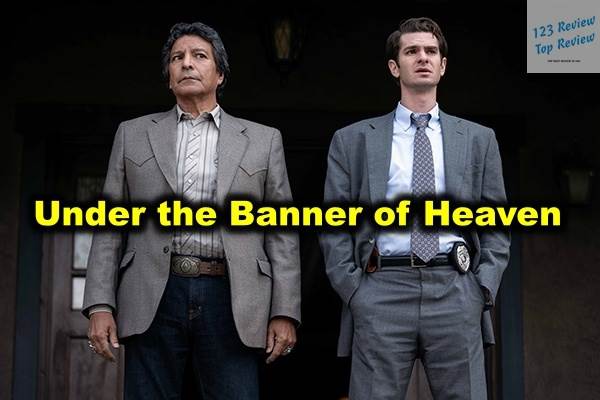“Under the Banner of Heaven,” a compelling true crime drama, has garnered significant attention for its nuanced exploration of faith, fanaticism, and the intricate dynamics within a religious community. Adapted from Jon Krakauer’s critically acclaimed book of the same name, the series is a dark, introspective journey into the complex interplay between belief and violence.
In this article, 123 Review will provides an in-depth analysis of the series, covering its critical reception, character development, thematic elements, narrative structure, cinematic techniques, and the broader social and cultural impact.
Critical Reception
Overview of Reviews
Upon its release, “Under the Banner of Heaven” sparked widespread discussion among critics and audiences alike. The series received praise for its thought-provoking narrative and the way it tackles sensitive issues with a mix of reverence and critique. Andrew Garfield’s portrayal of Detective Jeb Pyre was highlighted as a standout, with many reviewers commending his ability to convey the character’s internal struggle between his faith and the harsh realities he uncovers. The supporting cast, including Daisy Edgar-Jones and Sam Worthington, also received accolades for their intense and emotionally charged performances.

However, the series was not without its criticisms. Some reviewers pointed out that the pacing, particularly in the middle episodes, lagged at times, which could detract from the overall tension. Others noted that the adaptation from Krakauer’s book to screen, while generally effective, sometimes struggled to balance the dense historical content with the dramatic elements of the story. Despite these critiques, the series was generally well-received, with many lauding it as a powerful exploration of complex themes.
Audience Reactions
The audience reception of “Under the Banner of Heaven” was overwhelmingly positive, especially among viewers with an interest in true crime, religious studies, and character-driven dramas. The series resonated with many for its raw and unflinching look at the consequences of religious extremism, as well as its portrayal of the personal toll such beliefs can take on individuals and communities.
Viewers expressed particular appreciation for the show’s willingness to delve into uncomfortable topics, such as the dark side of religious zealotry and the often-overlooked stories of women within these communities. The series’ portrayal of Detective Pyre’s crisis of faith struck a chord with many, as it echoed broader societal debates about the role of religion in modern life. However, the series also sparked controversy, particularly among members of the Mormon community, who felt that the portrayal of their faith was sometimes unfair or sensationalized.
Comparison with Other True Crime Dramas
“Under the Banner of Heaven” stands apart from many other true crime dramas due to its deep exploration of the intersection between religion and violence. While many series in this genre focus primarily on the crime itself and the procedural aspects of solving it, this series takes a more holistic approach, examining the psychological, emotional, and spiritual dimensions of the characters involved.
In comparison to other notable true crime dramas like “Mindhunter” or “The Sinner,” “Under the Banner of Heaven” places a greater emphasis on the internal conflicts of its characters, particularly in relation to their faith. The series also differs in its use of historical flashbacks and its focus on a real-life religious community, which adds layers of complexity to the narrative. This approach makes the series not just a story about a crime, but a meditation on the broader implications of belief systems and how they can be manipulated to justify extreme actions.
Character Analysis
Detective Jeb Pyre: A Study of Faith and Conflict
Detective Jeb Pyre, portrayed with remarkable depth by Andrew Garfield, serves as the moral and emotional center of “Under the Banner of Heaven.” As a devout Mormon and a dedicated law enforcement officer, Pyre is thrust into a situation that forces him to confront the darker aspects of his faith. His investigation into the Lafferty family murders leads him down a path of personal and spiritual turmoil, as he grapples with the realization that the very beliefs he has built his life upon may be connected to unspeakable acts of violence.
Garfield’s performance captures the essence of a man caught between two worlds: one of faith and the other of justice. Throughout the series, Pyre’s internal conflict intensifies as he is confronted with the brutal realities of religious extremism within his own community. His journey is a powerful depiction of how deeply held beliefs can be challenged and the profound impact that such a crisis can have on an individual’s identity and worldview. Pyre’s character is a study in the fragility of faith when it is tested by the stark realities of human nature and the complexities of moral righteousness.
The Lafferty Family Dynamics
The Lafferty family is central to the narrative of “Under the Banner of Heaven,” representing a microcosm of the dangers inherent in religious extremism. The family, particularly the brothers Ron and Dan Lafferty, are depicted as both products and perpetrators of a distorted interpretation of Mormon beliefs. The series delves into their transformation from devout followers to radicalized zealots, exploring the psychological and social factors that contributed to their descent into fanaticism.
Ron Lafferty, played with chilling intensity, embodies the dangers of charismatic leadership within a religious context. His gradual shift from a respected community member to a radicalized figurehead illustrates the seductive power of absolute certainty and the perilous path it can lead to. Dan Lafferty, on the other hand, serves as a cautionary tale of the influence of manipulative leadership on vulnerable individuals. The dynamics between the brothers, as well as their interactions with other family members, highlight how religious fervor, when taken to extremes, can destroy familial bonds and lead to tragic consequences.
Supporting Characters: Role and Impact
The supporting characters in “Under the Banner of Heaven” play crucial roles in advancing the narrative and adding depth to the central themes of the series. Brenda Lafferty, whose tragic fate is the catalyst for the investigation, is portrayed as a figure of strength and integrity, whose challenge to the patriarchal structures within her community ultimately leads to her demise. Her character serves as a stark reminder of the dangers faced by those who dare to question or defy deeply entrenched beliefs.
Other supporting characters, such as the various members of the Mormon community, contribute to the rich tapestry of perspectives that the series presents. These characters reflect the diversity of thought and belief within the community, from those who adhere strictly to traditional teachings to those who, like Pyre, find themselves questioning the very foundations of their faith. The interactions between these characters and the central figures of the story add layers of complexity to the narrative, making “Under the Banner of Heaven” a multifaceted exploration of belief, doubt, and the human condition.
Themes and Motifs
Exploration of Faith and Fanaticism
“Under the Banner of Heaven” is, at its core, an exploration of the fine line between faith and fanaticism. The series raises important questions about the nature of belief and the potential for it to be twisted into something dangerous when taken to extremes. Through the portrayal of the Lafferty family and their radicalization, the series examines how religious teachings can be interpreted in ways that justify violence and oppression.
The theme of fanaticism is not only explored through the actions of the Lafferty brothers but also through the broader community’s response to their crimes. The series challenges viewers to consider how societies can become complicit in allowing extremism to flourish when they fail to critically examine their beliefs or address the warning signs of radicalization. This exploration is both timely and timeless, as it speaks to the ongoing global conversations about the role of religion in society and the dangers of ideological extremism.
Gender Roles within the Mormon Community
Another significant theme in “Under the Banner of Heaven” is the examination of gender roles within the Mormon community. The series portrays the rigid expectations placed on women and the consequences of challenging these roles. Brenda Lafferty’s story is a poignant illustration of this, as her independence and refusal to conform to traditional gender norms ultimately lead to her being targeted by the more radical members of the community.
The series highlights the patriarchal structures within the Mormon faith and how these structures can be manipulated to justify the subjugation of women. Through Brenda’s character and her interactions with other women in the community, “Under the Banner of Heaven” critiques the systemic inequalities that persist within religious institutions. The portrayal of these gender dynamics adds another layer of depth to the series, making it not only a story about crime but also a commentary on the broader social issues within religious communities.
The Influence of Joseph Smith and Foundational Beliefs
The series also delves into the historical and doctrinal aspects of Mormonism, particularly the influence of its founder, Joseph Smith. The teachings and legacy of Smith are woven throughout the narrative, serving as both a source of inspiration and a justification for the actions of the characters. The Lafferty brothers, in particular, interpret Smith’s teachings in ways that align with their extremist views, using his legacy to validate their descent into fanaticism.
This exploration of foundational beliefs is crucial to understanding the motivations of the characters and the broader themes of the series. By examining the historical context of the Mormon faith and how its teachings have been interpreted and reinterpreted over time, “Under the Banner of Heaven” provides a deeper understanding of the events that unfold. This historical perspective also raises important questions about the role of religious texts and leaders in shaping the beliefs and actions of their followers.
Narrative Structure
Timeline and Flashbacks
“Under the Banner of Heaven” employs a complex narrative structure that incorporates both a present-day investigation and historical flashbacks. This non-linear approach allows the series to explore the roots of the characters’ beliefs and actions, providing a rich context for the events of the main plot. The flashbacks to the early days of the Mormon Church and the lives of the Lafferty family members add depth to the narrative, making it not just a story about a crime but a broader exploration of history and belief.
The timeline shifts between past and present are handled with care, ensuring that the audience can follow the intricate connections between the different time periods. This structure also adds to the suspense and tension of the series, as viewers slowly piece together the events that led to the tragic murders. The use of flashbacks is particularly effective in highlighting the contrasts between the idealized past and the harsh realities of the present, underscoring the central themes of faith, fanaticism, and the passage of time.
Pacing and Suspense
The pacing of “Under the Banner of Heaven” is deliberately measured, allowing the tension to build gradually as the investigation unfolds. While some critics noted that the series could be slow at times, this pacing is essential to the storytelling, as it mirrors the careful and methodical nature of Detective Pyre’s investigation. The slow burn of the narrative creates a sense of unease and foreboding, as the audience is drawn deeper into the dark undercurrents of the story.
The suspense is further heightened by the series’ use of visual and auditory cues, such as ominous music and stark, shadowy cinematography. These elements combine to create an atmosphere of dread, making the moments of violence and revelation all the more impactful. The pacing also allows for the exploration of the characters’ internal struggles, particularly Pyre’s crisis of faith, which is central to the emotional resonance of the series.
Conclusion and Resolution
The conclusion of “Under the Banner of Heaven” is both harrowing and thought-provoking. As the investigation reaches its climax, the series does not shy away from the brutal realities of the crimes or the deep-seated issues within the community. The resolution of the central mystery is both satisfying and unsettling, as it leaves viewers with lingering questions about the nature of belief, justice, and redemption.
The series ends on a contemplative note, with Detective Pyre grappling with the implications of what he has uncovered. His journey throughout the series has been one of profound transformation, and the conclusion reflects the lasting impact of the events on his faith and worldview. The ending is neither wholly pessimistic nor optimistic, but rather a realistic portrayal of the complexities of life and belief in the face of overwhelming tragedy.
Cinematic Techniques
Visual Style and Symbolism
“Under the Banner of Heaven” employs a visual style that is both stark and evocative, using symbolism to enhance the narrative. The cinematography often juxtaposes the beauty of the Utah landscape with the darkness of the events unfolding within it, creating a powerful contrast that underscores the themes of faith and fanaticism. The series makes effective use of light and shadow, with many scenes bathed in a harsh, almost unforgiving light that reflects the characters’ internal struggles.
Symbolism is woven throughout the series, with recurring motifs such as crosses, religious iconography, and images of isolation. These symbols serve to reinforce the central themes of the story, particularly the tension between faith and doubt. The visual style of the series is a crucial element in creating its haunting and introspective atmosphere, drawing viewers into the complex world of the characters and the moral dilemmas they face.
Sound and Music
The sound design and music of “Under the Banner of Heaven” play a vital role in establishing the mood and tone of the series. The soundtrack, composed of haunting, minimalist pieces, complements the visual style, creating an atmosphere of unease and tension. The music often mirrors the internal conflicts of the characters, with dissonant tones and eerie melodies reflecting their psychological turmoil.
The use of silence is also notable in the series, with moments of quiet often carrying as much weight as the dialogue or music. This silence is particularly effective in scenes of introspection or revelation, allowing the audience to fully absorb the gravity of the situation. The sound design, including the use of ambient noise and subtle audio cues, adds to the immersive experience, making “Under the Banner of Heaven” not just a visual journey but an auditory one as well.
Editing and Scene Transitions
The editing of “Under the Banner of Heaven” is precise and deliberate, with careful attention paid to the pacing and flow of the narrative. Scene transitions are smooth, often using visual or thematic connections to link different time periods or perspectives. This technique helps to maintain the coherence of the story despite its non-linear structure, allowing the audience to follow the complex narrative with ease.
The editing also plays a crucial role in building suspense, with the timing of cuts and the pacing of scenes contributing to the overall tension. The series often lingers on certain moments, allowing the emotional weight of the scene to fully register with the audience. This approach enhances the impact of key moments, making them resonate long after the episode has ended.
Social and Cultural Impact
Conversations About Faith and Violence
“Under the Banner of Heaven” has sparked important conversations about the relationship between faith and violence, particularly within religious communities. The series raises critical questions about how belief systems can be used to justify extreme actions and the responsibility of religious institutions in addressing these issues. The portrayal of the Lafferty family’s radicalization has led to discussions about the dangers of unchecked religious zealotry and the potential for doctrine to be manipulated to serve harmful agendas.
The series has also contributed to broader debates about the role of religion in modern society, particularly in the context of law enforcement and justice. Detective Pyre’s struggle to reconcile his faith with the realities of the case reflects a larger societal issue of how religious beliefs can influence, and sometimes conflict with, professional duties and ethical considerations.
Representation of Mormonism
The portrayal of Mormonism in “Under the Banner of Heaven” has been a point of both interest and contention. While the series has been praised for its detailed and nuanced depiction of the faith, it has also faced criticism from some quarters for its focus on the darker aspects of the religion. Members of the Mormon community have expressed concern that the series may reinforce negative stereotypes or misunderstandings about their beliefs and practices.
However, the series has also been recognized for its efforts to present a balanced view, acknowledging the diversity within the Mormon community and the positive aspects of the faith. The inclusion of multiple perspectives within the series allows for a more comprehensive exploration of Mormonism, highlighting both its strengths and the challenges it faces. This approach has made “Under the Banner of Heaven” a significant cultural touchstone in the ongoing conversation about religion and its role in contemporary society.
Influence on the True Crime Genre
“Under the Banner of Heaven” has made a notable impact on the true crime genre, particularly in its approach to storytelling and character development. By focusing on the psychological and spiritual dimensions of the case, the series has set a new standard for how true crime stories can be told. Its emphasis on the internal conflicts of the characters, rather than just the procedural aspects of the investigation, has inspired other series to adopt a more character-driven approach to the genre.
The series has also been influential in its use of historical context and its exploration of the broader social and cultural implications of the crime. This approach has expanded the scope of true crime storytelling, encouraging viewers to think more deeply about the underlying issues that contribute to criminal behavior. As a result, “Under the Banner of Heaven” has become a reference point for future true crime narratives, shaping the way these stories are told and received by audiences.
Conclusion
“Under the Banner of Heaven” is a powerful and thought-provoking series that delves deep into the complexities of faith, fanaticism, and the human condition. Through its compelling narrative, rich character development, and meticulous attention to detail, the series offers a profound exploration of the dangers of religious extremism and the impact it can have on individuals and communities. As both a true crime drama and a meditation on belief, “Under the Banner of Heaven” stands as a significant contribution to contemporary television, sparking important conversations and setting a new standard for the genre.





